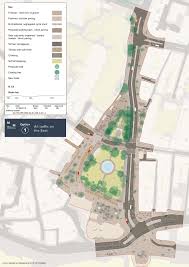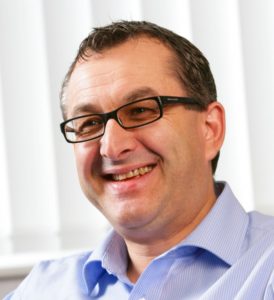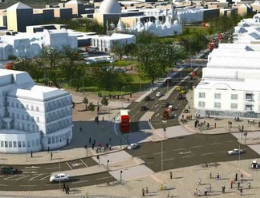Millions of pounds are to be spent changing the layout of the Old Steine area but the project could cost all of us much more if the wrong approach is taken.
The risk is that businesses are unable to receive vital deliveries when they need them, jams make Brighton a much less attractive place to visit and pollution gets worse rather than better.
Road safety is cited by the council’s current Labour administration as a reason to do away with the Aquarium roundabout and put in a “T” junction and traffic lights.
But the numbers don’t stack up. The 40-second delay at the proposed T junction will have a negative impact on the local economy – on jobs and businesses – estimated to cost more than £17 million.
And there is no evidence that a reasonably safe stretch of road will be made significantly safer by a redesign that few people in the area actually support.
Are the Conservatives suggesting that Brighton and Hove City Council does nothing? Far from it. Even amid the flawed consultation that is said to have taken place, there are possibilities that could work for people living, working and travelling in the area.
The business case has now been published and responses to the consultation are being made which only amplify the concerns voiced by the Conservatives.
But if the Labour administration remains determined to replace the roundabout with a T junction, it risks bringing the whole project down.
The T junction element has so many economic dis-benefits that it will, if properly assessed, so outweigh the benefits that the Coast to Capital Local Enterprise Partnership (LEP) will struggle to award vital funding.
Labour admits in the business case that the traffic light delays alone will hurt the economy. But it does not appear to have assessed or included the impact of the 120-plus coaches and buses that daily use Madeira Drive once there is only one exit – at Duke’s Mound.
There are no plans to change the Duke’s Mound junction with Marine Parade so how will coaches and buses turn left without crossing both carriageways? Imagine the jams, the delays and the pollution – not to mention the new road safety risks.
Taxi and private hire drivers will pay for this mess too, as they will end up going expensively out of their way as a result of the new layout. And their passengers will have to pay the price with no economic assessment being made of the impact to the city’s own 1,100 licensed taxi and private hire vehicles.
Nor is there any mention of how the exciting Waterfront project and the T junction will be future-proofed to ensure that the new concert and conference centre can accommodate tens of thousands of people coming and going.
We need to provide efficient mass transport solutions to and from the city centre so why are we now limiting our options?
We have a fantastic variety of business sectors in Brighton and Hove yet Labour seems to have overlooked the key role of tourism. It supports 22,000 jobs and is worth a staggering £900 million a year.
The business case focuses on things like active travel, land values, public realm changes and knowledge-based businesses. But there is no economic assessment of how tourism will be affected.
Now is not the time to do anything that could remotely harm tourism, not least given how reliant the council is on the sector for rents and business rates.
Crucially, the case for altering the Aquarium roundabout is not necessarily linked to the Old Steine regeneration. It appears more to do with casualty numbers.
We all wish there were no casualties but based on Labour’s own predicted fall in casualties (44 per cent), the T junction will still have the highest number of casualties in Brighton.
To put it into context, based on Labour’s own figures, over a five-year data period, there has been only one pedestrian casualty rated as severe – and no deaths.
One casualty is one too many. However, with 50,000 vehicle journeys through the aquarium roundabout each day, equalling 91 million journeys over five years, there is a 1 in 91 million chance of a pedestrian being severely injured.
The odds of winning the National Lottery are 1 in 45 million – and over the same five years there were tragically 2,104 deaths from 171 million commercial flights. In reality, you are twice as likely to win the lottery or 1,000 times more likely to die in a plane crash than be severely injured as a pedestrian at the Aquarium roundabout.

We have asked a number of questions in recent weeks seeking specific details on accidents and how they happened. We have asked for comparable accident data elsewhere in Brighton and Hove. We have asked for a breakdown of the economic benefits and dis-benefits presented in the business case.
Regretfully our questions have not been answered and we are told that the model doesn’t allow for the financial data to be broken down. Computer says “no”.
The business case appears to sweep away the concerns and negative impacts of the T junction by recommending that the decision to proceed should be made because of the benefits to the wider Valley Gardens scheme.
That is frankly not good enough. To “lose” the negative impact of changing the Aquarium roundabout because other disconnected areas are better will not prevent the economic downturn to those who rely on driving through the T junction or those who rely on tourism.
Further, the financial implications in the report to the council’s Environment, Transport and Sustainability (ET&S) Committee identify a total budget of £7.25 million of which the city will contribute £1.25 million. However, in the same report costs are projected to be £7.84 million with the potential to rise by 20 per cent. Before the project starts there is a projected overspend that will only weaken the already fragile business case.
There is a solution, however. It is known as “option 3” and involves buses and taxis and private hire vehicles running up and down the western side of the Old Steine. Crucially, this phase of the scheme – phase three – should adopt option 3 and except for some minor improvements, do nothing to the Aquarium roundabout.

The Conservatives will present amendments when the ET&S Committee meets next Tuesday (27 November) to decide how to proceed. It may mean a delay to the decision but we have one chance to get this right. If we get this wrong, the impact will be significant and long-lasting.
Labour delayed decisions on the first two phases of this scheme for two years so that it could look at the traffic modelling in more detail and using more up-to-date information. We are asking Labour to support our amendments so that we get this right for the future of our city.
Four years ago Councillor Gill Mitchell, Labour’s lead on the ET&S Committee, said: “We are being asked to take on trust that replacing the Palace Pier roundabout with a giant T junction will work.
“I would urge Conservative councillors to rethink their support for this scheme, which gives every appearance of being made up on the hoof.”
We don’t see that anything has changed and we would hope that Councillor Mitchell reflects on her own words and doesn’t perform a U-turn on this busy junction.
We would also hope that Councillor Alan Robins – Labour’s lead on tourism and a member of the ET&S Committee – will recognise the significant risk that this scheme poses to the very industry he is supposed to support and promote.
If Labour doesn’t apply the brakes now, it risks driving our local economy into an easily avoidable crash.
Councillor Lee Wares is the Conservative spokesman on the Environment, Transport and Sustainability Committee on Brighton and Hove City Council.









No mention of the changes to bus routes and bus stops which will have a huge impact in the Old Steine area. During an hour long debate on Valley Gardens last month Councillors didn’t even mention buses. There will be less space for bus stops leading to more congestion. Ousting buses from the stops outside the Royal Pavilion means buses will have to share space the main traffic lanes on the east side of the Steine. Brighton & Hove Buses is pressing for a new southbound bus lane south of Edward Street which would be used by 100 buses an hour. 50 million passengers use local buses each year, more per head than anywhere else outside London. Buses are vital to our local economy, helping to provide a good alternative to cars for many. Councillors need to remember that their constituents use buses even if they don’t!
I am puzzled that there is opposition to doing away with that unpleasant roundabout. After all, other junctions on the seafront road
do not have roundabouts (such as Grand Avenue and Hove Street). It would be interesting to see why that roundabouut was created.
Simple.. to keep the traffic moving in all directions and to allow traffic to change directions. As I stated at the meeting last night…
Replacing the Aquarium Roundabout with a T-Junction and Phased Traffic Lights will cause a negative impact on the seafront resulting in delays and congestion both to the East and West of the junction.
Currently all traffic coming out of East Street & Little East Street….. and the small slip road in front of the ‘Jurys Inn Waterfront Hotel’….. and from the taxi rank…..intending …to go…… Westbound …. has to head East to the roundabout….. to loop back round because there is a ‘No… Right…. Turn’.
Coming out of Pool Valley… again….there is ‘No…. Right… Turn’.
So how does any of this traffic wanting to go West….do this ….without the roundabout?
We consider that none of this has been thought about.
How many accidents have there been at the roundabout since it’s been in existence. And does the bloke who draws up the plans still live in Lewes. Half the reason Brighton gets so congested is because a person who doesn’t live here or even come here does the planning. It’s bad enough the cock up at Victoria gardens let alone making another one.
The present ’roundabout’ isn’t the original one which was much larger and in my opinion much easier to navigate does anyone know why it was made into a smaller one?
There used to be one at the Preston Circus also.
Once again the council appear to have overlooked the fact that we are a tourist destination. Lots of people come from far away in those things called cars which the council seem to hate so much. Once you’ve bought a car, and taxed and insured it, it’s far more cost effective to travel with a family in a car than by train or bus. And yet still no decent park and ride (someone should check out Oxford – great scheme there).
Anyway, it’s a waste of money changing the roundabout and will only slow things down. It won’t be more convenient for anyone. I think the council have to change things just to show they’ve done something and justify their existence.
Er, that again. Where, er, would you put it? And how to prevent cross-town journeys to it?
A roundabout allows the traffic to keep flowing and the current small one allows cars to circle the junction two abreast. The current pedestrian crossings are set back from the junction which helps traffic move across the junction itself without stopping at the roundabout, and this gives cars and buses heading in other directions more chance to move on freely when just one pedestrian crossing light is activated.
The new proposals are way better for pedestrians but at the expense of moving traffic because the pedestrian crossings are at the junction, meaning all exits will be stopped when pedestrians cross at one crossing. As a van driver, I think this is a mistake.
As a cyclist and a walker, I’m not convinced the mixing of cycle lanes and pedestrian footpaths is a good idea.
The entry to Madeira Drive is narrowed to a single lane under these proposals and that whole seafront section becomes one way, which just creates another bottle neck and makes vehicles drive further.
It seems to me the current proposals are a disaster for anyone on an essential journey, be it commuting to work or delivering goods, or indeed for the buses. Other parts of the scheme don’t seem to show lay byes for bus stops, meaning that any bus pulling over at a stop will hold up the traffic, including all the other buses.
I frequently have to cross the city via this junction and there is no alternative route. Nor is there a park and ride scheme for those wishing to visit the city centre and needing to arrive by car.
It’s one thing to discourage traffic from coming into the city centre but there are no alternative routes across the city and creating new bottle necks adds to journey times, and creates more pollution from the static cars.
I think you make an important point Billy. This isn’t an attempt to make traffic flow more freely or increase vehicle capacity, it is an attempt to make the area ‘friendlier’ to pedestrians and cyclists.
The problem is, with the increase in standing traffic this will cause, it will likely have the opposite effect. A similar motive was behind the recent but less ambitious pavement widening changes to the Dyke pub X-roads which I walk across daily. Longer waits, more fumes, worse experience for motorists, cyclists and pedestrians alike.
Roundabouts are good IMO. They keep the traffic moving. The health damage from pollution concerns me more than the risk of being run over. I can avoid being run over by looking where I am going. I can’t avoid breathing fumes from stationary vehicles though.
the whole of the Lewis road project leading up to farmer in both directions has been a monumental mess designe only to serve the university and not the inhabitants or visitors to brighton the so called improvement works from the level to the seafront are only going to gridlock the town
I am so looking forward to moving away from Brighton. Amateur politicians who could not find their buttocks with both hands completely destroying the city.
Let’s face it, they’ve made a total mess of every other road layout change, most of which seem totally unnecessary. Why not spend millions on this and take the money from all those useless services like care services etc or maybe we should spend our council tax on another British Airways tourist failure!
I’ve left my comments on the consultation – this will grid-lock the city throughout the summer and every day during the rush hour. The traffic lights will introduce a delay to all traffic, the reduction in the number of lanes will reduce how many vehicles per hour can transit the junction, and Madeira Drive one way will cause chaos at the top of Dukes Mound. Whoever has planned this hasn’t looked at the knock-on effects from the changes to other parts of the city. Another comment mentions park n ride -we absolutely need one, there is space at Waterhall or just over the road near the RSPCA, with very good road links that don’t need to cross the city for access, so let’slook at the whole problem, not just one critical junction.
What a load of drivel! It’s a globally proven fact roundabouts do not work at high capacity junctions. Furthermore the current layout means pedestrians and cyclists find it difficult and dangerous to navigate.
We are a tourist destination and there isn’t a city in the world that has been complimented on its roundabouts. This scheme will finally link the pier to the city without navigating narrow pavements and multiple pedestrian crossings that prioritise cars.
Having needed surgery after being hit by a careless driver on my bike and witnessed someone being hit by a bus I think any councillor who suggests 40 second wait at traffic lights is more important than road safety is a pretty vile individual.
This old news story has come back up on my news feed, on january 1st 2025.
I’m no Tory voter, but what is said here is very true.
Removing the Palace Pier roundabout is an obvious act of self harm for the city.
The latest plan, under VG3, to direct pedestrians and a new cycle lane straight at this busy junction, is an act of madness, and there’s no logical reason for this stupidity.